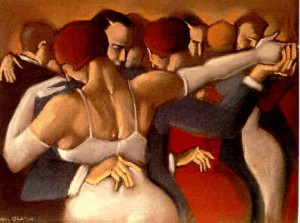What is Argentine Tango?
The partner dance, Argentine Tango, has been thrilling dancers of all levels for more than a century. This social dance is ever changing, filled with passion, drama, beauty and excitement. Tango is highly improvisational, which allows the dancers to navigate crowded dance floors, as well as to express themselves in a non-verbal manner. The essence of Argentine tango is about life and, especially, about the relationship between a man and a woman. Graciela Gonzales, a leading tango instructor, calls the dance “the history of love—for three minutes.”
Argentine Tango Lessons:
When you’re a beginning tango student, attending a class is the best way to get your bearings in the dance. Sign up and attend regularly. Private lessons are another form of learning that can accelerate the process. When an instructor does not have to watch/instruct a class full of people and can focus solely on your dancing, you can learn a tremendous amount! Learning to dance tango is a wonderful commitment you make for yourself, and consistency is as important to achieving this goal as it is for all other goals in your life. A good tango class should introduce you to elements such as: walking, turning, stopping, navigation, musicality and some embellishments. Tango is a dance based on walking so you must practice this essential element.
All great tango dancers work on their walk. In fact, one of the best compliments a tango dancer can receive is, “Look how well he walks!” After you’ve “walked your miles” you’ll learn how to turn, how to stop momentarily on the floor, how to navigate a crowded floor, how to listen to and learn the various types of tango music and how to add your own signature to the dance in the form of embellishments. Because tango is an improvisational dance, you should also be exposed to that aspect of the dance as well. Tango is a dance you create on the fly with another person. It isn’t about memorized steps that go together the same way every time. This is one of the most beautiful aspects of tango and is the one that makes the dance endlessly interesting.
Tango Music:
Differing from most popular music styles, Tango rarely uses drums (with the exception of Nuevo/electronic Tango music) but makes tremendous use of the Bandoneón. The more you listen, the quicker you will be able to understand and begin to predict (when possible) the flow of this creative music style. Listening, hearing, then interpreting the music through movement to your partner, is to dance a Tango. Start a collection of your own and listen to the music as often as you can.
Going to a “Milonga”:
At the Milonga (Tango Dance Party), the pure joy of dancing tango is found. A milonga refers to the event where tangos, milongas and valtzes are danced. At a milonga, music is played in sets called “tandas.” Usually three or four songs are played by the same orchestra followed by the “cortina” (the curtain) which signals the end of the tanda. If you ask someone to dance and they accept, it is assumed that it will be for the entire tanda. The cortina is supposed to be a piece of music that people know not to dance to. It’s your signal to smile, say thank you and (possibly) change partners.
How Someone Asks for a Dance:
In Argentina, men ask women to dance with a look—a certain glance, movement of the head toward the dance floor or smile that says, “Dance with me?” This can take place from far across the room if the right eyes are caught. If a woman wants to accept a dance with a man, she smiles back and (most important) keeps looking at him while he approaches her. The slightest glance away is usually interpreted as meaning “I’ve changed my mind and don’t want to dance.” This system is very wonderful and full of pitfalls. What if the asker is looking at the woman behind you? Did you really see a “yes” or a “maybe?” Because we are caught up in this Argentine art form, the practice of asking people to dance with the eyes is also followed to some extent. In many areas of the world, however, you may ask someone to dance directly or with your best Argentine eyes. As in the dance, practice makes perfect.
Accepting a Dance or Saying “No, thank you”
Accepting a dance is as simple as saying “yes.” You can do this with your eyes—be on the look out for people who ask the Argentine way—or by accepting a direct invitation. It is also perfectly acceptable to say, “No, thank you.” If you accept a dance, remember it will probably last for the remainder of the tanda that is playing—three or four songs if you start at the beginning. If either one of you decides that one or two dances is enough, however, either person can simply say “thank you” and begin leaving the dance floor. Once you say “thank you” to someone in a polite manner, the dance with that person is over.
Dancing at a Milonga as a Beginner:
As a beginner, you’ll either be eager to dance with everyone or hesitant to be seen as a beginner. If you’re eager to dance, go for it. Just remember that tango is danced in lanes that keep moving and the more experienced dancers tend to stay toward the outside. If you’re hesitant, I can guarantee you that everyone in the room has been a beginner at one time and understands how nerve wracking it can be to look around and see everyone gliding by when you only know three movements. Even someone who has been dancing for only two weeks longer than you have will look like they’ve been at it for years longer. I can’t explain it; it always looks like that. The way to become a good dancer is to show up and dance. As Woody Allen once said, “98 percent of success is showing up.”
Shoes & Attire for Tango Dancing:
Shoes for the Lady: The shoe can make all the difference… for better of worse. The most common Tango shoe have hard leather soles; the better to pivot gracefully with! Becoming popular as well, are ballroom/salsa shoes with suede soles. These will be slightly more flexible with extra traction on a wood floor; good for the beginner dancer that is concerned with slipping or dancing in hard soled shoes for hours on end. As your dancing progresses, I do recommend investing in a well made pair of Tango shoes for the long term.
Shoes for the Man: You should be comfortable enough to dance for hours… you will be in high demand, as we never have enough willing leaders! Dress shoes that are slightly slick (hard leather, suede etc) or Tango/Ballroom shoes. The shoes should stay on your feet (ie: lace up); loafers tend to slip off the heel & easier for the lady to get her heel stuck! Also, try to avoid rubber soled shoes that stick, unless they are made for dancing (dance sneakers). Sticky shoes are one of the top ways people twist their knees & ankles.
Attire: The standard attire for Milongas tends to be on the dressier side (for California, that is!). Semi formal and formal is common, with modern fashion (lady’s leggings, mini skirts, etc) making an appearance as well. Long sleeves for men is advisable. There is no strict dress code in general (unless stated by the specific event), these are just guidelines.
Final Thoughts:
Practice… often (alone and with partners if possible)!
Dance, enjoy & share… often!
This article was put together by Carina Fourmyle, the lead Argentine Tango instructor at ATOMIC Ballroom in Irvine, CA. Her classes are held typically on Saturday afternoons at 4pm. She is also available for private lessons at ATOMIC Ballroom.
ATOMIC Ballroom in Irvine, CA hosts a the Midnight Milonga on Saturday late nights.


Leave A Comment